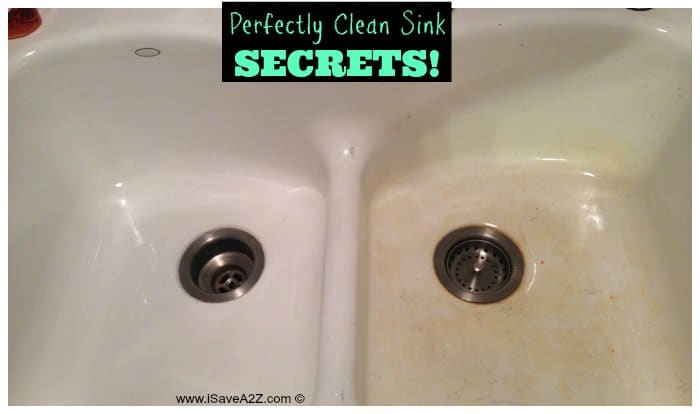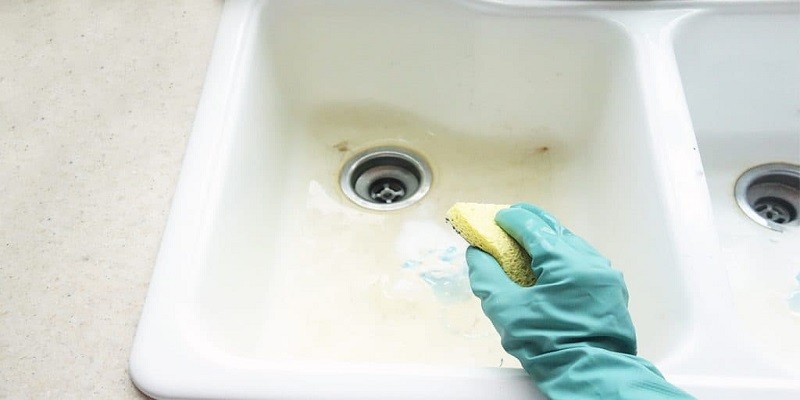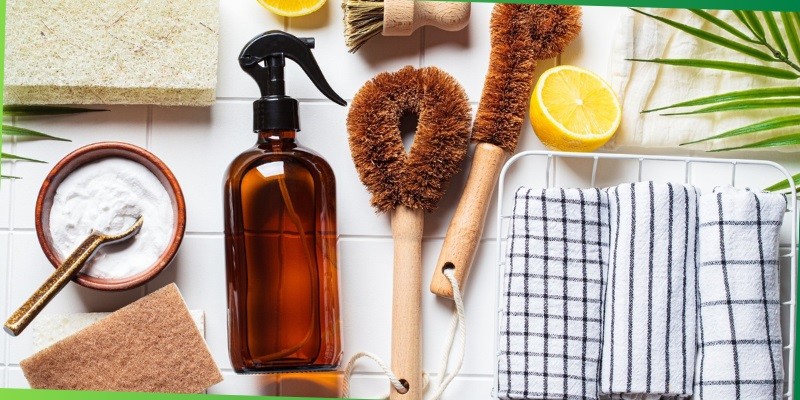Last Updated on October 18, 2023
To clean a white sink, start by scrubbing it using a mixture of baking soda and water. Then, rinse it thoroughly with warm water and finish by wiping it dry.
A clean white sink enhances the overall appearance of your kitchen or bathroom and gives a fresh and hygienic feel. Regular maintenance and cleaning of the sink also prevent the buildup of stains and grime, ensuring it remains in top condition for a longer time.
We will discuss various methods and tips for effectively cleaning a white sink, using readily available household ingredients to remove stubborn stains and maintain its cleanliness. So, let’s dive in and learn how to make your white sink shine!

Credit: www.isavea2z.com
Cleaning Supplies For A White Sink
White sinks are a classic and elegant addition to any kitchen or bathroom. However, keeping them sparkling clean can be quite a challenge. In this section, we will explore the best cleaning products and essential tools you need to effectively clean a white sink.
We will also discuss non-abrasive cleaning solutions suitable for sensitive surfaces. So, let’s dive in and discover the secrets of maintaining a pristine white sink.
Best Cleaning Products For A White Sink:
- Baking soda: This versatile and inexpensive product acts as a gentle abrasive and helps remove stains and grime from your white sink.
- White vinegar: Known for its powerful cleaning properties, white vinegar is effective in eradicating mineral deposits and hard water stains from your sink’s surface.
- Lemon juice: The natural acidity of lemon juice helps in cutting through grease and removing stubborn stains, leaving your white sink refreshed.
- Dish soap: A mild dish soap mixed with warm water can effectively clean your white sink without causing any damage to the surface.
Essential Tools Needed For Cleaning:
- Soft sponge or cloth: Opt for a non-abrasive sponge or cloth to prevent scratching the surface of your white sink while cleaning.
- Soft-bristle brush: A small soft-bristle brush can be used to clean hard-to-reach areas and around the drain of your white sink.
- Toothbrush: Reusing an old toothbrush is an excellent way to get into the tight corners and crevices of your sink, ensuring a thorough clean.
- Microfiber cloth: Microfiber cloths are ideal for drying and polishing your white sink, leaving it streak-free and gleaming.
Non-Abrasive Cleaning Solutions For Sensitive Surfaces:
- Hydrogen peroxide: Diluted hydrogen peroxide is a safe and effective option for removing tough stains on your white sink’s surface without damaging it.
- Baking soda paste: Mixing baking soda with water to form a paste creates a non-abrasive cleaning solution that can tackle stubborn stains gently.
- Castile soap: Made from natural ingredients, castile soap is a gentle and eco-friendly option for cleaning sensitive surfaces like a white sink.
- Rubbing alcohol: Diluted rubbing alcohol can remove water spots and stubborn stains from your white sink while being gentle on the surface.
By using these best cleaning products, essential tools, and non-abrasive cleaning solutions, you can maintain the pristine whiteness of your sink effortlessly. Regular cleaning and proper care will ensure that your white sink remains a shining centerpiece in your kitchen or bathroom.
Step By Step Guide On Cleaning A White Sink
Preparing The Sink For Cleaning:
To begin the process of cleaning your white sink, it is essential to prepare it properly. Here are the steps you can follow for this:
- Remove any items from the sink, such as dishes or utensils.
- Rinse the sink with warm water to get rid of any loose debris.
- Put on rubber gloves to protect your hands from cleaning agents.
- Prepare a cleaning solution by mixing equal parts of baking soda and water.
- Apply the solution to the sink’s surface, making sure to cover all areas.
- Let it sit for a few minutes to allow the baking soda to work its magic.
- Use a sponge or soft brush to scrub the sink gently.
Removing Stains And Discoloration:
Stains and discoloration can make your white sink appear dull and unclean. To address this issue, follow these steps:
- Create a paste by mixing equal parts of hydrogen peroxide and baking soda.
- Apply the paste on the stained or discolored areas of the sink.
- Let it sit for at least 10 minutes to allow the mixture to penetrate the stains.
- Gently scrub the sink using a sponge or soft brush.
- Rinse the sink thoroughly with warm water to remove the paste and any residue.
Scrubbing And Disinfecting The Sink:
To ensure your white sink is not only clean but also germ-free, follow these steps for scrubbing and disinfecting:
- Apply a small amount of mild dish soap or liquid cleaner to a sponge or soft brush.
- Scrub the entire sink, including the faucet and drain, using circular motions.
- Pay special attention to the corners and crevices where grime can accumulate.
- Rinse the sink thoroughly with warm water to remove any soap or cleaner residue.
- Disinfect the sink by spraying a mixture of equal parts water and white vinegar.
- Let it sit for a few minutes before rinsing again with warm water.
Polishing And Maintaining The Sink’S Shine:
To give your white sink a polished and shiny finish, follow these steps:
- Use a microfiber cloth or a soft towel to dry the sink completely.
- Apply a small amount of white vinegar to a cloth and wipe the sink’s surface.
- This will help remove any remaining water spots or mineral deposits.
- Once the sink is dry and clean, apply a small amount of mineral oil or olive oil.
- Use a clean cloth to buff the sink gently in circular motions.
- This will help restore the sink’s shine and protect it from future stains and discoloration.
Remember, regular maintenance is key to keeping your white sink looking pristine. By following these step-by-step instructions, you can ensure your sink remains clean, stain-free, and gleaming for years to come. Happy cleaning!
Diy Natural Cleaners For White Sinks
White sinks can add a touch of elegance to any kitchen or bathroom, but they can also be a magnet for stains and mineral deposits. Thankfully, you don’t need to rely on harsh chemical cleaners to keep your white sink sparkling clean.
With a few simple ingredients, you can create your own natural cleaning solutions that are not only effective but also eco-friendly. Here are two diy cleaners that can help you tackle tough stains and mineral deposits.
Homemade Cleaning Solutions For Eco-Friendly Cleaning:
- White vinegar and baking soda mixture:
- Mix equal parts white vinegar and baking soda to form a paste.
- Apply the paste to the stained areas of the sink.
- Let it sit for 15-20 minutes to allow the mixture to break down the stains.
- Scrub the sink gently using a soft brush or sponge.
- Rinse the sink thoroughly with warm water.
- The acidic properties of vinegar combined with the abrasive action of baking soda can effectively remove tough stains from your white sink.
- Lemon and salt scrub:
- Cut a fresh lemon in half.
- Sprinkle a generous amount of salt onto one of the lemon halves.
- Scrub the sink with the lemon half, using the salt as an abrasive agent.
- Pay extra attention to areas with mineral deposits.
- Rinse the sink with warm water to remove any residue.
- Lemon contains natural acids, which can break down mineral deposits, while the salt helps to scrub them away.
Using these diy natural cleaners can help maintain the pristine white appearance of your sink without the use of harsh chemicals. Give them a try and enjoy a clean and eco-friendly white sink!
Frequently Asked Questions Of How To Clean A White Sink?
How Do You Clean A White Sink?
To clean a white sink, apply a mixture of baking soda and water, scrub with a sponge, and rinse thoroughly.
What Is The Best Way To Remove Stains From A White Sink?
To remove stains from a white sink, make a paste of baking soda and hydrogen peroxide, apply it to the stains, scrub gently, and rinse.
Can I Use Bleach To Clean My White Sink?
Yes, you can use bleach to clean a white sink. Dilute it with water, apply it using a sponge, scrub gently, and rinse thoroughly.
How Often Should I Clean My White Sink?
It is recommended to clean a white sink at least once a week to prevent stains and buildup of residue.
How Can I Keep My White Sink Looking Shiny And New?
To keep your white sink looking shiny and new, avoid leaving coffee grounds, tea bags, or other staining substances in your sink for extended periods. Regularly clean and rinse with a mild detergent and warm water.
Conclusion
Maintaining the cleanliness of a white sink is crucial to maintaining its pristine appearance. By following the step-by-step guide provided in this blog post, you can easily keep your sink looking brand new. Regularly cleaning with gentle yet effective products such as baking soda or white vinegar can remove stubborn stains and prevent the buildup of mineral deposits.
Using a soft cloth or sponge and a little elbow grease, you can effortlessly restore the sink’s shine. Remember to avoid abrasive cleaners and tools that can scratch the surface. Additionally, implementing preventive measures like using sink mats or wiping away spills promptly can reduce the chances of staining and discoloration.
With proper care and maintenance, your white sink will continue to be a focal point of your kitchen or bathroom, contributing to an inviting and clean living space.










